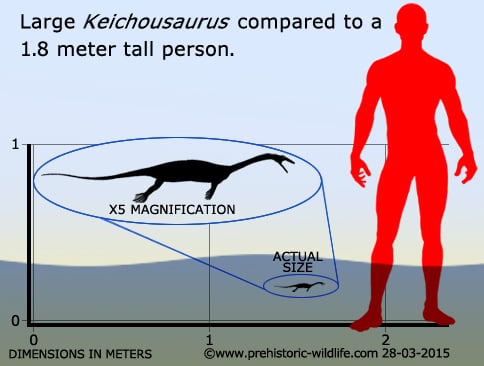In Depth
Keichousaurus looks like a miniature plesiosaur, and indeed many have looked into the possibility that it may either be a direct ancestor, or representative of an ancestral form that led to the evolution of the giant plesiosaurs.
As well as resembling the later plesiosaurs, Keichousaurus may have moved like them too, using their flattened fore limbs to push themselves along. Study of the caudal vertebrae also suggests strong muscle attachment, implying that the tail could have also provided some form of propulsion, perhaps as a throwback to its earlier terrestrial ancestors.
Because of these specialised limbs, it is thought by many that Keichousaurus would have spent most of its time in the water. However, there are some specimens that show a differently developed ulna that could have supported limited movement on the land. Study of Keichousaurus individuals of different ages has also shown aliometric growth, meaning that different body parts grew at different rates to other parts.
Some fossils of Keichousaurus have been recovered with what appear to be young Keichousaurus inside of the main specimen. Their position and completion inside of the main fossil suggest that they are not in the stomach, but are actually young waiting to be born. This implies that Keichousaurus was viviparous and gave birth to live young as opposed to laying eggs. This further reinforces the view that Keichousaurus was a primarily marine creature.
Because Keichousaurus skeletons are often so well preserved, they make popular collectors pieces. However, care should be taken as some fossils that are sold as genuine, are actually reproductions of original fossils. The reproductions still make nice collectors pieces, but do not warrant the price tags of the originals. As with anything, try to find a reputable dealer.
Further Reading
– On the new Pachypleurosauroidea from Keichow, south-west China. – Vertebrata PalAsiatica 2(2-3):72-81 – C. -C. Young – 1958. – On the new nothosaurs from Hupeh and Kweichou, China. – Vertebrata PalAsiatica 9(4):337-356. – C. -C. Young – 1965. – New information on sexual dimorphism and allometric growth in Keichousaurus hui, a pachypleurosaur from the Middle Triassic of Guizhou, South China. – Acta Palaeontologica Polonica 60 (3): 681–687. – Yifan Xue, Dayong Jiang, Ryosuke Motani, Olivier Rieppel, Yuanlin Sun, Zuoyu Sun, Cheng Ji & Pengfei Yang – 2013.










